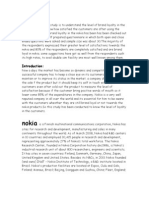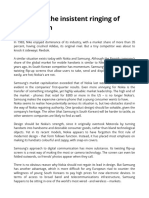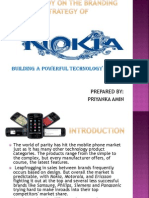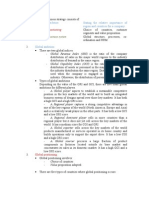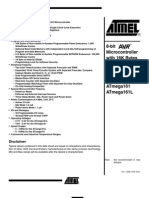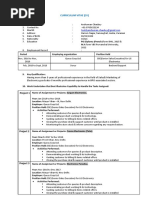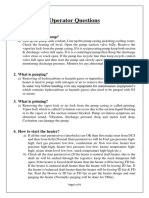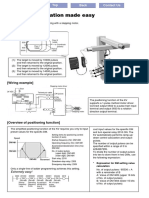Nokia History
Nokia History
Uploaded by
Paritosh GuptaCopyright:
Available Formats
Nokia History
Nokia History
Uploaded by
Paritosh GuptaOriginal Description:
Original Title
Copyright
Available Formats
Share this document
Did you find this document useful?
Is this content inappropriate?
Copyright:
Available Formats
Nokia History
Nokia History
Uploaded by
Paritosh GuptaCopyright:
Available Formats
History of nokia
Nokia's history starts in 1865, when engineer Fredrik Idestam established a wood-pulp mill in southern Finland and started manufacturing paper. Due to the European industrialization and the growing consumption of paper and cardboard Nokia soon became successful. In 1895 Fredrik Idestam handed over the reins of the company to his son-in-law Gustaf Fogelholm. Nokia's products were exported first to Russia and then to the UK and France. The Nokia factory attracted a large workforce and a small community grew up around it. A community called Nokia still exists on the riverbank of Emkoski in southern Finland. The Nokia Community attracts other Companies The hydroelectricity (from the river Emkoski) which the wood-pulp mill used also attracted the Finnish Rubber Works to establish a factory in Nokia. In the 1920s, the Rubber Works started to use Nokia as their brand name. In addition to footwear (galoshes) and tyres, the company later went on to manufacture rubber bands, industrial parts and raincoats. Expanding into Electronics After World War II the Finnish Rubber Works bought the majority of the Finnish Cable Works shares. The Finnish Cable Works was a company that had grown quickly due to the increasing need for power transmission and telegraph and telephone networks. Gradually the ownership of the Rubber Works and the Cable Works companies consolidated. In 1967 the companies were merged to form the Nokia Group (link to Nokia company logos). The Finnish Cable Works had manufactured cables for telegraph and telephone networks and in the 1960 they establishmed the Cable WorksElectronics department. At this time the seeds of Nokia's global success in telecommunications were planted. In 1967, when the Nokia Group was formed, Electronics generated three percent of the Group's net sales and provided work for 460 people. The Journey into Telecommunications Nokias Cable Work's Electronics department started to conduct research into semiconductor technology in the 1960s. This was the beginning of Nokias journey into telecommunications. In the early 1970s, the majority of telephone exchanges were electro-mechanical analog switches. Nokia began developing the digital switch (Nokia DX 200) which became a success. Nokia DX 200, which was equipped with high-level computer language and Intel microprocessors gradually evolved into the multifaceted platform that is still the basis for Nokia's network infrastructure today. At the same time, new legislation allowed the Finnish telecommunications authorities to set up a mobile network for car phones that was connected to the public network. The result was Nordic Mobile Telephony (NMT). Opening in 1981, NMT was the world's first multinational cellular network. During the following decade, NMT was introduced in many other countries and launched the rapid expansion of the mobile phone industry. At the end of the 1980s a common standard for digital mobile telephony was developed. This standard is known as GSM (Global System for Mobile Communications). In 1991 Nokia made agreements to supply
GSM networks to nine European countries and by August 1997 Nokia had supplied GSM systems to 59 operators in 31 countries. New Products During the 1980s, Nokia's operations rapidly expanded to new business sectors and products. The strategy was to expand rapidly on all fronts. In 1988, Nokia was a large television manufacturer and the largest information technology company in the Nordic Countries. Focusing on Telecommunications During the deep recession in Finland at the beginning of the 1990s, the telecommunications and mobile phones divisions were the supporting pillars of the Nokia. Despite the depth of the recession, Nokia came to its feet quickly as the company started streamlining its businesses. In May 1992 Nokia made the strategic decision to divest its non-core operations and focus on telecommunications. The company's 2100 series phone was an incredible success. In 1994, the goal was to sell 500,000 units. Nokia sold 20 million. It has been rumored that a group of businessmen tried to offer Nokia to the swedish telecom company Ericsson during the recession (1990s)! Today, Nokia is a world leader in digital technologies, including mobile phones, telecommunications networks, wireless data solutions and multimedia terminals. We have the permission to use pictures in this article from the official Nokia website. Nokia.
You might also like
- A Viewpoint On Calidad Pascual's Competitive StrategyDocument25 pagesA Viewpoint On Calidad Pascual's Competitive StrategyMinh PhuongNo ratings yet
- Innovation at Unilever - The FoundryDocument16 pagesInnovation at Unilever - The FoundryAster TyphNo ratings yet
- BMGC Chapter OneDocument50 pagesBMGC Chapter Oneadithya100% (1)
- Group ONE Final Report Import Process at KUEHNE NAGEL CO. LTD OfficialDocument40 pagesGroup ONE Final Report Import Process at KUEHNE NAGEL CO. LTD OfficialTrần Khã NhiNo ratings yet
- ASSESSMENT SCOR Model (OM)Document3 pagesASSESSMENT SCOR Model (OM)Rahul AgarwalNo ratings yet
- UPS AnalysisDocument3 pagesUPS AnalysisMuhammad Mubasher RafiqueNo ratings yet
- PESTL Singapore - Strategic Analysis On SingTelDocument21 pagesPESTL Singapore - Strategic Analysis On SingTelWooGimChuan100% (5)
- Coca ColaDocument36 pagesCoca Colay2imranNo ratings yet
- Incoterms Guide TFGDocument38 pagesIncoterms Guide TFGRamona Ion100% (1)
- PH M Tú Anh/ F12-018.: Student Name /ID Number Unit Number and TitleDocument21 pagesPH M Tú Anh/ F12-018.: Student Name /ID Number Unit Number and Titlephạm tú anhNo ratings yet
- Case AnalysisDocument7 pagesCase AnalysisRadhika ChhabraNo ratings yet
- Mud Plug InstallationDocument4 pagesMud Plug InstallationVahid TaghdiriNo ratings yet
- A Project Report On IT Applications in Manufacturing Sector: (2007 - 2008) Guided byDocument46 pagesA Project Report On IT Applications in Manufacturing Sector: (2007 - 2008) Guided byohsagar2000100% (1)
- Wonderware Allen-Bradley 1784-KT I/O Server: User's GuideDocument80 pagesWonderware Allen-Bradley 1784-KT I/O Server: User's GuideHalcon90100% (1)
- The Nokia Story...Document35 pagesThe Nokia Story...Nilesh SolankiNo ratings yet
- Research On Nokia Brand LoyaltyDocument14 pagesResearch On Nokia Brand LoyaltyFaizan Hayat100% (1)
- Strategy Management Assignment TomTom Case Study 2013Document15 pagesStrategy Management Assignment TomTom Case Study 2013Kenneth MoNo ratings yet
- DB Schenker Trend ReportDocument20 pagesDB Schenker Trend ReportHoang Viet Anh LeNo ratings yet
- Finland Nokia Case StudyDocument11 pagesFinland Nokia Case StudyBitan BanerjeeNo ratings yet
- Samsung: and Product Line Product Width and Product DepthDocument9 pagesSamsung: and Product Line Product Width and Product DepthShivani PanchalNo ratings yet
- Eassay Assignment - Law102 - Truongvnhe141641 - IB1504Document9 pagesEassay Assignment - Law102 - Truongvnhe141641 - IB1504Trưởng Vũ NhưNo ratings yet
- Nokia and The Insistent Ringing of CompetitionDocument2 pagesNokia and The Insistent Ringing of Competitionescorpio123pNo ratings yet
- Nokia Case StudyDocument13 pagesNokia Case StudyPriyanka AminNo ratings yet
- Mô Phỏng Kinh DoanhDocument20 pagesMô Phỏng Kinh DoanhNguyễn Hồng PhượngNo ratings yet
- BITISDocument7 pagesBITISVõ Trà MyNo ratings yet
- Case Study No. 3Document4 pagesCase Study No. 3CJ IbaleNo ratings yet
- Module 11 AssignmentDocument8 pagesModule 11 AssignmentMuafa BasheerNo ratings yet
- Viettel PostDocument17 pagesViettel Postnhunglth2750No ratings yet
- Porters Five Forces in China FinalDocument5 pagesPorters Five Forces in China Finalprachii09No ratings yet
- Nike A Powerhouse CaseDocument17 pagesNike A Powerhouse CaseHugo RodríguezNo ratings yet
- Group 6 - Case Study OptimizationDocument17 pagesGroup 6 - Case Study OptimizationLinh ChiNo ratings yet
- Chapter 12 CSDocument4 pagesChapter 12 CSKashaf FatimaNo ratings yet
- PESTEL SamsungDocument3 pagesPESTEL SamsungAli Faisel100% (1)
- LGDocument78 pagesLGgouravchouhan3167% (3)
- Integrated Marketing Communications Concept of McdonaldDocument9 pagesIntegrated Marketing Communications Concept of McdonaldKamlesh SoniwalNo ratings yet
- Mid-Term Report: Overview of A.P. Møller - Mærsk A/S and Maersk Vietnam LTDDocument12 pagesMid-Term Report: Overview of A.P. Møller - Mærsk A/S and Maersk Vietnam LTDChấn HưngNo ratings yet
- Finland NokiaDocument34 pagesFinland Nokiarahul_agrawal_36No ratings yet
- Tisco Erp Case StudyDocument2 pagesTisco Erp Case StudyPravin Bajaj0% (1)
- BYD ReportDocument15 pagesBYD ReportAnmol GeorgeNo ratings yet
- Agenda: Company Profile. Information Systems. Information Systems at Apple Erp at Apple Implementing Erp. ProposalsDocument29 pagesAgenda: Company Profile. Information Systems. Information Systems at Apple Erp at Apple Implementing Erp. ProposalsMuhammad SubhaniNo ratings yet
- Failed Joint Ventures ExampleDocument7 pagesFailed Joint Ventures ExampleDivya NairNo ratings yet
- COVISINTDocument21 pagesCOVISINTDivya PunjabiNo ratings yet
- Global Strategy-Lesserie PhilippeDocument10 pagesGlobal Strategy-Lesserie PhilippePrashant BedwalNo ratings yet
- Global Supply Chain of The Intel Corporation: June 2017Document12 pagesGlobal Supply Chain of The Intel Corporation: June 2017Tạo CôngNo ratings yet
- Task 1 Theo Thoi GianDocument18 pagesTask 1 Theo Thoi GianLinh100% (1)
- Nine Dragons Paper CaseDocument6 pagesNine Dragons Paper CaseSameh RizkNo ratings yet
- Re - BrandingDocument14 pagesRe - Brandingchimanshu77888No ratings yet
- What Is CompetitiveDocument5 pagesWhat Is CompetitiveMorals Walls RichardNo ratings yet
- Assignment 1 BriefDocument17 pagesAssignment 1 BriefMinh Thi TrầnNo ratings yet
- Viettel Telecom Corporation Marketing Plan in Cambodia: Prepared By: Group 4 MembersDocument26 pagesViettel Telecom Corporation Marketing Plan in Cambodia: Prepared By: Group 4 MembersJonathan Vuong NguyenNo ratings yet
- Advantages and Disadvantages of Transnational CorporationsDocument6 pagesAdvantages and Disadvantages of Transnational CorporationsCobraSnakewaNo ratings yet
- Toyota Global Strategy and Specific Strategy in ChinaDocument7 pagesToyota Global Strategy and Specific Strategy in ChinaYK ZhouNo ratings yet
- SCM of Samsung ElectronicsDocument20 pagesSCM of Samsung ElectronicsĐinh Công Thành100% (1)
- VodafoneDocument26 pagesVodafoneManisha BishtNo ratings yet
- Info On LGDocument71 pagesInfo On LGbeejoyNo ratings yet
- Eurocham-WhiteBook 2017.en ReduceSizeDocument175 pagesEurocham-WhiteBook 2017.en ReduceSizeQuyen Nguyen100% (2)
- Samsung ElectronicsDocument22 pagesSamsung ElectronicsThanh Kim Phuc NguyenNo ratings yet
- China Telecom Case StudyDocument3 pagesChina Telecom Case Studyinvincibleboy20005553No ratings yet
- Globalisation and Competitiveness: OECD Science, Technology and Industry Working Papers 1996/05Document62 pagesGlobalisation and Competitiveness: OECD Science, Technology and Industry Working Papers 1996/05basjuanNo ratings yet
- Case StudyDocument1 pageCase StudysmallsalanganeNo ratings yet
- NokiaDocument1 pageNokiaapi-26403048No ratings yet
- History of NokiaDocument8 pagesHistory of NokiaAteeq LaghariNo ratings yet
- UPE Topup PrepaidDocument2 pagesUPE Topup PrepaidParitosh GuptaNo ratings yet
- Formulae KJNDocument8 pagesFormulae KJNParitosh GuptaNo ratings yet
- Cse (205) : Data Structures: SynopsisDocument4 pagesCse (205) : Data Structures: SynopsisParitosh GuptaNo ratings yet
- RPT Studentfee ReceiptDocument1 pageRPT Studentfee ReceiptParitosh GuptaNo ratings yet
- Marauder Broch SMALLDocument16 pagesMarauder Broch SMALLscorpion2001gla100% (1)
- The DES Algorithm IllustratedDocument70 pagesThe DES Algorithm IllustratedCARLOSMIGUEZNo ratings yet
- Readme Free-0.7Document9 pagesReadme Free-0.7Instituto Argentino AlbertNo ratings yet
- CADWorx P&ID User GuideDocument367 pagesCADWorx P&ID User Guideمحمد اجمعين0% (1)
- EN81-28 Risk of Trapping FlowChart v3Document1 pageEN81-28 Risk of Trapping FlowChart v3Ashraful ShohagNo ratings yet
- Total Capital Investment SummaryDocument7 pagesTotal Capital Investment SummaryChewy ChocoNo ratings yet
- Project Report Group 4Document28 pagesProject Report Group 4Akame TakashitaNo ratings yet
- Datasheet Atmega 161 PDocument159 pagesDatasheet Atmega 161 PprincebahariNo ratings yet
- CV AnshumanDocument2 pagesCV AnshumanAnshumanNo ratings yet
- Business Continuity Planning at Financial Institutions: July 2003 Bank of JapanDocument14 pagesBusiness Continuity Planning at Financial Institutions: July 2003 Bank of Japan15vinayNo ratings yet
- Operator QuestionsDocument4 pagesOperator Questionskalosha917No ratings yet
- AccountDocument5 pagesAccountMark Angelo Gelido FernandezNo ratings yet
- ASTM E18-05 Ap Note Rockwell Hardness and Rockwell Superficical Hardness PDFDocument4 pagesASTM E18-05 Ap Note Rockwell Hardness and Rockwell Superficical Hardness PDFyeniNo ratings yet
- A Complete Solution For Your Operation: Key BenefitsDocument1 pageA Complete Solution For Your Operation: Key BenefitsJuan RenteriaNo ratings yet
- Hexagon Manufacturing Solutions Final ReportDocument119 pagesHexagon Manufacturing Solutions Final ReportCayure DiegoNo ratings yet
- Mobilgrease XHP 222 MSDS PDFDocument8 pagesMobilgrease XHP 222 MSDS PDFFolpoNo ratings yet
- Hydrogen Purity Analysis For Fuel Cell VehiclesDocument1 pageHydrogen Purity Analysis For Fuel Cell VehiclesNational Physical LaboratoryNo ratings yet
- 7thPhDSeminar On Wind Energy in Europe - Full ProgramDocument8 pages7thPhDSeminar On Wind Energy in Europe - Full ProgramAbdel Salam AlsabaghNo ratings yet
- Zoho Entry ListDocument29 pagesZoho Entry ListDhaval DadhaniaNo ratings yet
- Design of Rigid Pile Caps Through An Iterative Strut-And-Tie ModelDocument12 pagesDesign of Rigid Pile Caps Through An Iterative Strut-And-Tie ModeljjohnsoneNo ratings yet
- Motor Control Solutions 01 PDFDocument2 pagesMotor Control Solutions 01 PDFRaviNo ratings yet
- Question Bank - Cycle Test - 2Document2 pagesQuestion Bank - Cycle Test - 2Apurva DesaiNo ratings yet
- Demo 1Document13 pagesDemo 1supreethsrini.1989No ratings yet
- Mock Call ScriptDocument2 pagesMock Call ScriptDhan VelaNo ratings yet
- PLDT in Tuguegarao City, Cagayan - Yellow Pages PH PDFDocument1 pagePLDT in Tuguegarao City, Cagayan - Yellow Pages PH PDFKim BalungayaNo ratings yet
- New 007 2011 HyDocument2 pagesNew 007 2011 HyРома БлошенкоNo ratings yet
- ICCCECS574 Modified New1Document6 pagesICCCECS574 Modified New1srinu85rajuNo ratings yet















